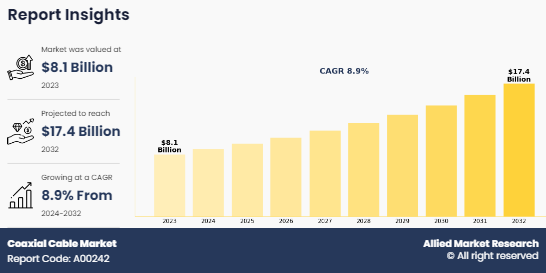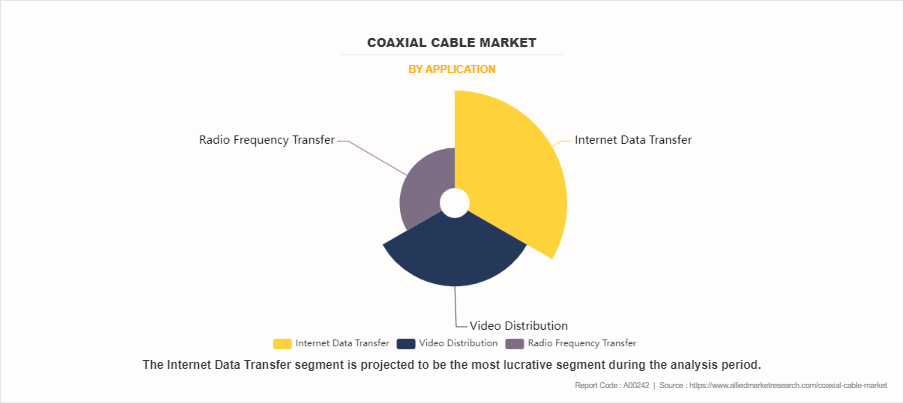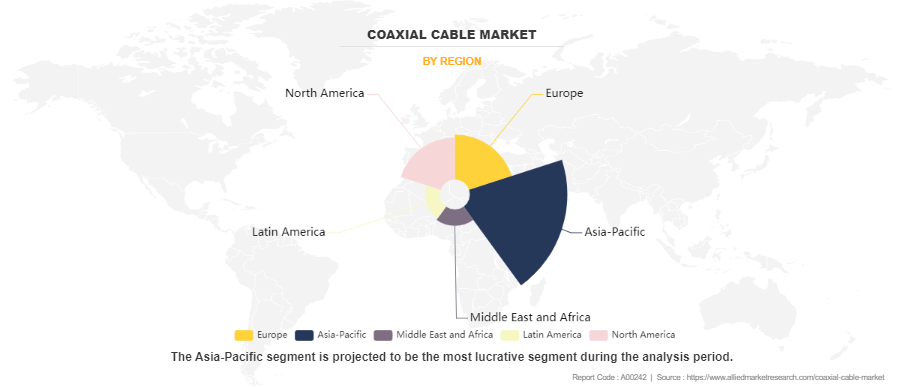Coaxial Cable Market Research, 2032
The global coaxial cable market was valued at $8.1 billion in 2023, and is projected to reach $17.4 billion by 2032, growing at a CAGR of 8.9% from 2024 to 2032. The COVID-19 pandemic had significantly disrupted the global coaxial cable market growth, primarily due to supply chain interruptions and reduced manufacturing capacities. However, the increased demand for reliable internet and telecommunication services during lockdowns has somewhat offset these challenges by driving the need for enhanced network infrastructure.

A coaxial cable is a type of electricity cable with a crucial conductor, usually made from copper or aluminum, surrounded by way of an insulating layer and a steel protect. This layout reduces sign interference and loss, making coaxial cables perfect for sending audio, video, and information indicators over long distances. Furthermore, the external wiring acts as a grounding and insulating device, shielding the inner wiring from external electric interference. In addition, it is widely employed in television, internet, and telecommunications systems to enable dependable and high-quality signal transmission.
In addition, the durability and resistance to electromagnetic interference (EMI) position them as versatile and reliable transmission mediums throughout diverse packages. Their strong creation, comprising an important conductor, insulating layer, and metallic shielding, guarantees durability, making them appropriate for challenging environments and disturbing business settings. Moreover, coaxial cables excel at transmitting tv indicators, internet connectivity, and other information with minimal sign degradation over extended distances. Their capability to withstand EMI safeguards in opposition to signal distortions, imparting clear and regular verbal exchange within systems. Furthermore, coaxial cables are used in radio frequency (RF) programs, including broadcasting and telecommunications due to their capacity to efficaciously deliver high-frequency alerts. The defensive prevents sign leakage and external interference, making sure the integrity of the transmitted RF signals. This makes coaxial cables essential for connecting antennas, transmitters, and receivers in radio and television broadcasting.
Factors such as reliable performance in military and aerospace systems, and cost-effectiveness for short-distance data transmission positively influence the development of the market. In addition, compatibility of coaxial cable with existing infrastructure and resistance to electromagnetic interference are expected to fuel the growth of the market during the forecast period. Furthermore, the collaboration of coaxial cable with fiber optics is expected to provide lucrative growth opportunities for the market in the upcoming years. Moreover, innovations in cable design and materials and demand for coaxial cable in specialized areas such as industrial automation propel the global market growth. However, vulnerability to physical damage, bandwidth limitations, and susceptibility to signal loss over long distances are expected to hamper market growth.
The report focuses on growth prospects, restraints, and trends of the coaxial cable market analysis. The study provides Porter’s five forces analysis to understand the impact of various factors, such as bargaining power of suppliers, competitive intensity of competitors, threat of new entrants, threat of substitutes, and bargaining power of buyers, on the coaxial cable industry.
Segment review
The coaxial cable market size is segmented on the basis of application, end-use industry, and region. By application, the market is segmented into internet data transfer, video distribution, and radio frequency transfer. On the basis of end-use industry, the market is segmented into aerospace and defense, internet service provider, television, telecommunication service provider, and others. Region-wise, it is analyzed across North America, Europe, Asia-Pacific, Latin America, and MEA.

On the basis of application, the internet data transfer segment dominated the market share in 2023 and, is expected to maintain its dominance during the forecast period, as coaxial infrastructure is already in place in many areas, making it a readily available option for internet access. However, the radio frequency transfer segment is expected to exhibit the highest growth during the forecast period, as solid metal outer conductor acts as a barrier, protecting the inner conductor carrying the RF signal from external electromagnetic interference (EMI). This is crucial for maintaining signal integrity, especially in environments with lots of electrical noise, such as near power lines or other electronic devices.

By region, Asia-Pacific dominated the market share in 2023 for the coaxial cable industry owing to connect remote population and remote area with broadband connectivity. However, MEA is expected to exhibit the highest growth during the forecast period. This is attributed to growing investment in smart city and village initiatives, aimed at increasing digitalization and efficiency in urban and rural areas.
Competition Analysis
Competitive analysis and profiles of the major players in the global coaxial cable market include General Cable Corporation, Belden Inc., Amphenol Corporation, LS Cable & System, TE Connectivity Ltd., Coleman Cable Inc., Nexans S.A., L-Com Global Connectivity, Prysmian Group, and Alpha Wire. These major players have adopted various key development strategies such as business expansion, new product launches, and partnerships, which help to drive the growth of the coaxial cable market globally.
Recent Product Launches in the Coaxial Cable Market:
In April 2023, Times Microwave Systems launched XtendedFlex 178 continuous flex coaxial cable. XtendedFlex 178 delivers optimal bend movement and consistent electrical performance during continuous flexure. It features a unique combination of materials, such as a stranded silver-plated copper-clad steel center conductor, FEB dielectric, tin-plated copper braid and a rubber jacket. The cable offers flexibility and durability to survive the rigors of millions of flexures.
Market landscape and trends
The demand for high-performance coaxial cables in telecommunications and data networking continues to grow, driven by the need for enhanced bandwidth and minimal signal loss. The coaxial cable market size is also impacted through the growing deployment of advanced technology in diverse industries, which includes healthcare, automotive, and aerospace. The transition to higher frequency programs, pushed via emerging technologies such as 5G and the Internet of Things (IoT), has brought about the improvement of coaxial cables with stepped forward abilities to deal with higher statistics charges and frequencies. In addition, there is a growing recognition on environmentally sustainable cable production practices, aligning with broader enterprise traits toward green answers.
Top Impacting Factors
Rise in demand for high-performance coaxial cables in telecommunications and data networking
Coaxial cables are used in diverse segments of 5G networks, consisting of the backhaul and fronthaul connections due to the deployment of 5G networks requiring sturdy and excessive-performance communication infrastructure. These cables play a critical function in transmitting signals with low latency and excessive reliability, helping the elevated information speeds and connectivity needs associated with the 5G era. Furthermore, coaxial cables are utilized to set up dependable connections among these gadgets and the significant network infrastructure.
Growing focus on environmentally sustainable cable
Traditional coaxial cables use substances that are not environmentally friendly or have an excessive environmental effect however, producers are now exploring and adopting materials which are more sustainable, recyclable, and have a lower ecological footprint. This consists of the use of substances which can be loose from harmful materials and contribute to lowering electronic waste, which in flip is predicted to provide moneymaking opportunity for the marketplace. Moreover, sustainable coaxial cables are being designed with a longer lifespan and sturdiness, minimizing the want for frequent replacements. In addition, manufacturers are exploring approaches to make cables without problems upgradable or repairable to extend their operational life, which in flip is a main aspect riding the growth of the marketplace.
Technological advancements in Coaxial Cable
As the demand for higher records speeds and increased bandwidth has grown, coaxial cables have gone through advancements to aid higher frequencies. These upgrades enable the transmission of extra information over the same cable, making them suitable for applications which includes excessive-velocity net, multimedia streaming, and 5G networks. Moreover, technological advancements have brought about the development of low-loss dielectric materials, lowering sign attenuation and taking into consideration longer transmission distances without compromising performance. Therefore, coaxial cable won wider traction amongst cease-customers, which in flip, is expected to contribute to sturdy market growth.
Key benefits for stakeholders
This report provides a quantitative analysis of the market segments, current trends, estimations, and dynamics of the coaxial cable market forecast from 2023 to 2032 to identify the prevailing market opportunities.
Market research is offered along with information related to key drivers, restraints, and opportunities of coaxial cable market outlook.
Porter's five forces analysis highlights the potency of buyers and suppliers to enable stakeholders to make profit-oriented business decisions and strengthen their supplier-buyer network.
In-depth analysis of the coaxial cable market segmentation assists in determining the prevailing coaxial cable market share.
Major countries in each region are mapped according to their revenue contribution to the global market.
Market player positioning facilitates benchmarking and provides a clear understanding of the present position of the market players.
The report includes an analysis of the regional as well as global coaxial cable market trends, key players, market segments, application areas, and market growth strategies.
Coaxial Cable Market Report Highlights
| Aspects | Details |
| Forecast period | 2023 - 2032 |
| Report Pages | 200 |
| By Application |
|
| By End User |
|
| By Region |
|
| Key Market Players | Nexans S.A., LS Cable & System, Prysmian Group, L-Com Global Connectivity, Inc., General Cable Corporation, TE Connectivity Ltd., Alpha wire, Coleman Cable Inc., Amphenol Corporation, Belden Inc. |
Analyst Review
The growth of coaxial cables is propelled by several key factors that underscore their essential role in modern communication infrastructure. One primary driver is the escalating demand for high-speed and reliable internet connectivity. With the increasing reliance on bandwidth-intensive applications, such as video streaming, online gaming, and virtual collaboration tools, the need for efficient data transmission has become paramount. Coaxial cables, renowned for their ability to carry large amounts of data over long distances with minimal signal loss, are a preferred choice for broadband internet services. The advent of 5G technology further amplifies this demand, as coaxial cables are instrumental in supporting the higher frequency ranges required for ultra-fast wireless communication.
Another crucial factor contributing to the growth of coaxial cables is the rapid expansion of the Internet of Things (IoT) and smart home technologies. As homes and businesses integrate a myriad of connected devices, from smart thermostats to security cameras, coaxial cables serve as a backbone for creating robust and interconnected networks. Their ability to transmit data reliably and securely makes coaxial cables indispensable for ensuring seamless communication among diverse IoT devices. In addition, the ongoing development of smart cities and infrastructure projects worldwide is fueling the demand for coaxial cables. These cables play a pivotal role in supporting advanced communication systems, such as intelligent transportation networks, surveillance systems, and real-time data monitoring. As urban areas continue to evolve into interconnected hubs of technology, coaxial cables provide the necessary infrastructure to enable efficient and responsive communication.
The coaxial cable market is also buoyed by the continuous innovation and upgrades within the aerospace and defense sectors. These cables are crucial in military applications, supporting communication, radar systems, and electronic warfare capabilities. The geopolitical landscape and the need for secure and robust defense infrastructure contribute to sustained growth in the demand for coaxial cables. For instance, in October 2023, Carlisle Interconnect Technologies (CarlisleIT), a division of Carlisle Companies, launched ECS Lightning series avionics coax, which adds two new 50 Ω coaxial cables to its existing trusted lineup of ECS avionics cables. In addition, CarlisleIT has innovated its avionics coax solutions to provide maximum performance in an extremely low weight cable. The two cables have silver-coated copper-clad aluminum conductors and helical aluminum shields to decrease the weight of the coax and minimize attenuation. The Lightning series cables bring your signals through loud and clear without adding unwanted pounds.
The coaxial cable market is estimated to grow at a CAGR of 8.9% from 2024 to 2032.
The coaxial cable market is projected to reach $17.4 billion by 2032.
The coaxial cable market is expected to witness notable growth owing to compatibility of coaxial cable with existing infrastructure and resistance to electromagnetic interference.
The key players profiled in the report include General Cable Corporation, Belden Inc., Amphenol Corporation, LS Cable & System, TE Connectivity Ltd., Coleman Cable Inc., Nexans S.A., L-Com Global Connectivity, Prysmian Group, and Alpha Wire.
The key growth strategies of coaxial cable market players include product portfolio expansion, mergers & acquisitions, agreements, geographical expansion, and collaborations.
Loading Table Of Content...
Loading Research Methodology...


